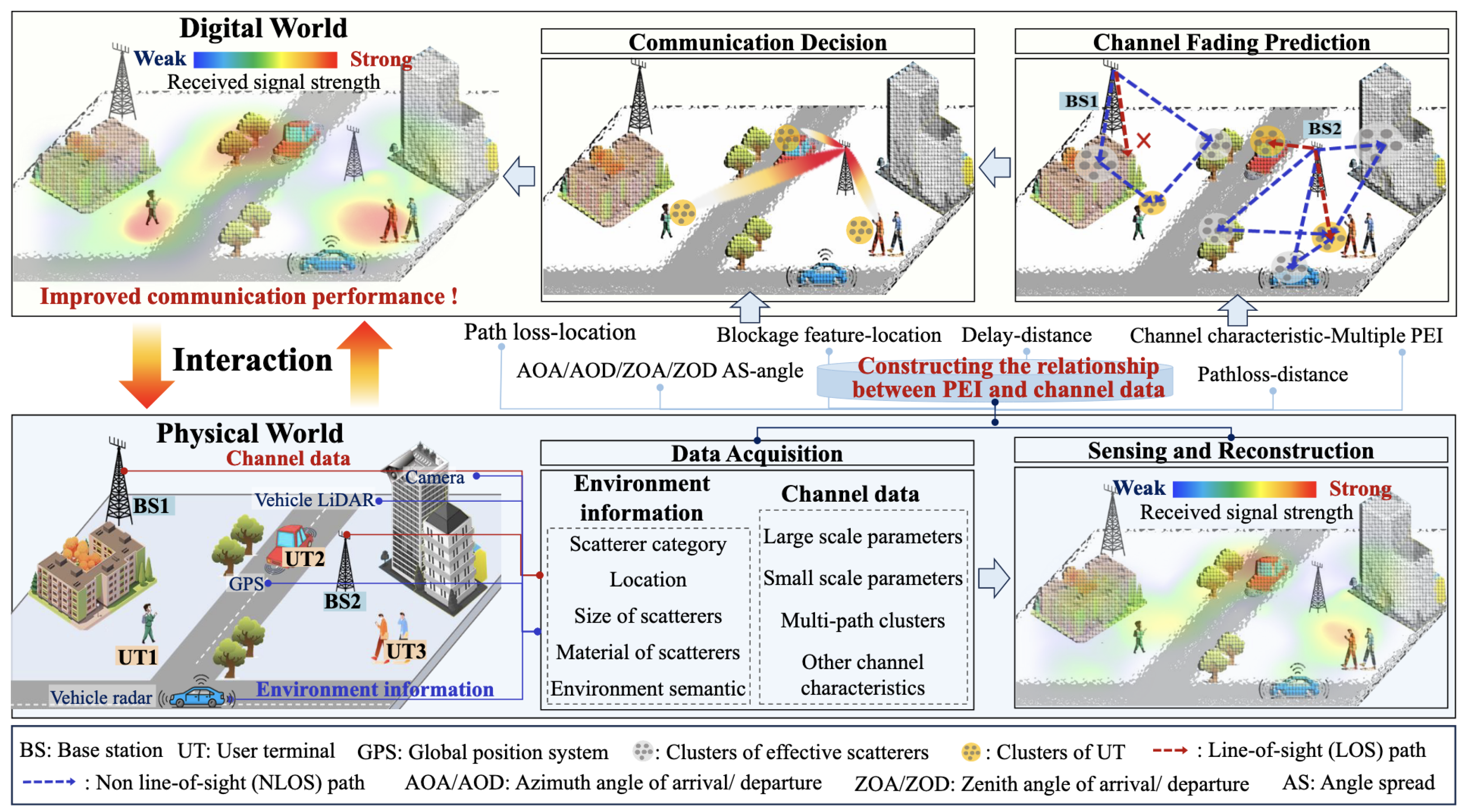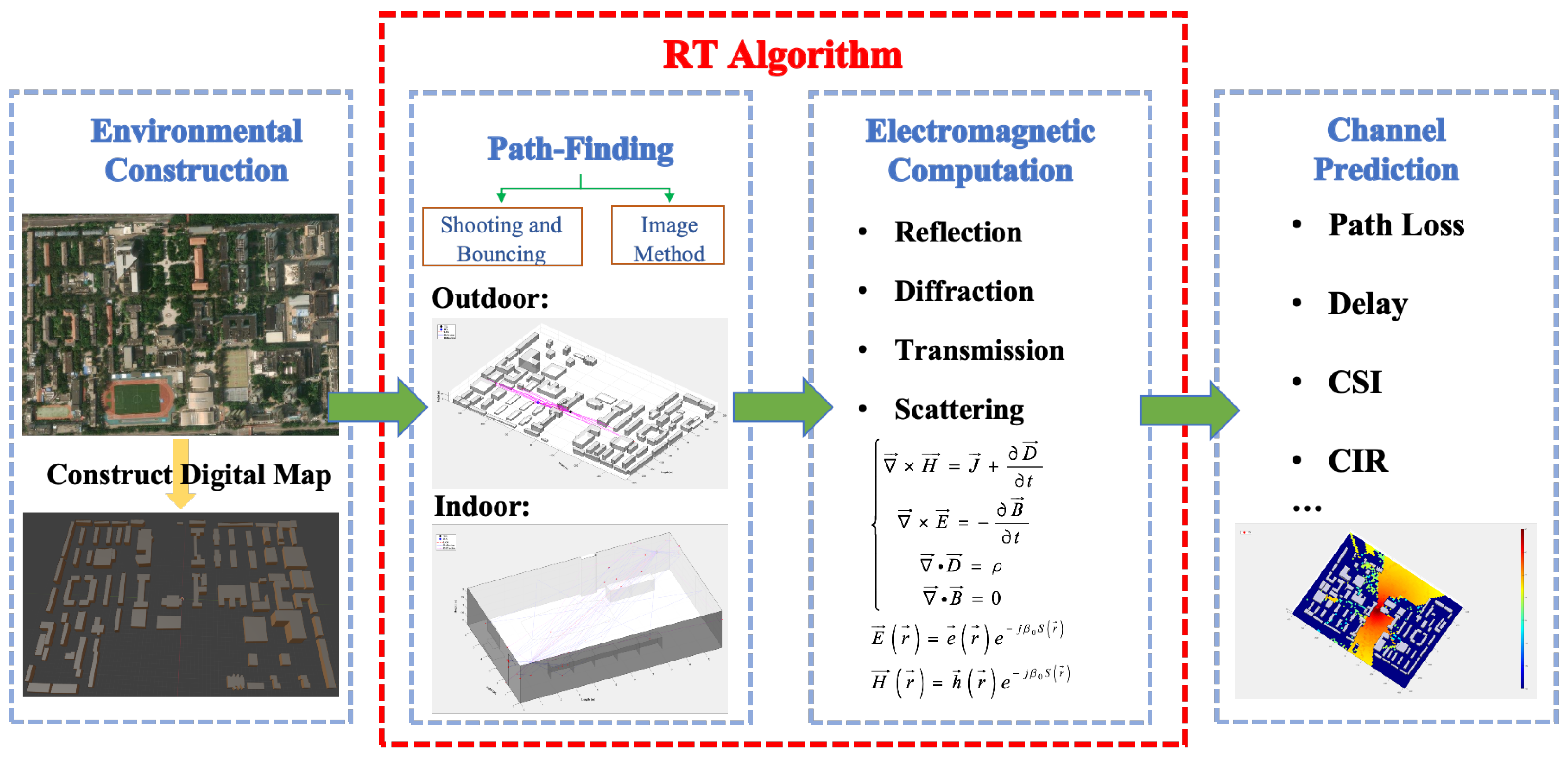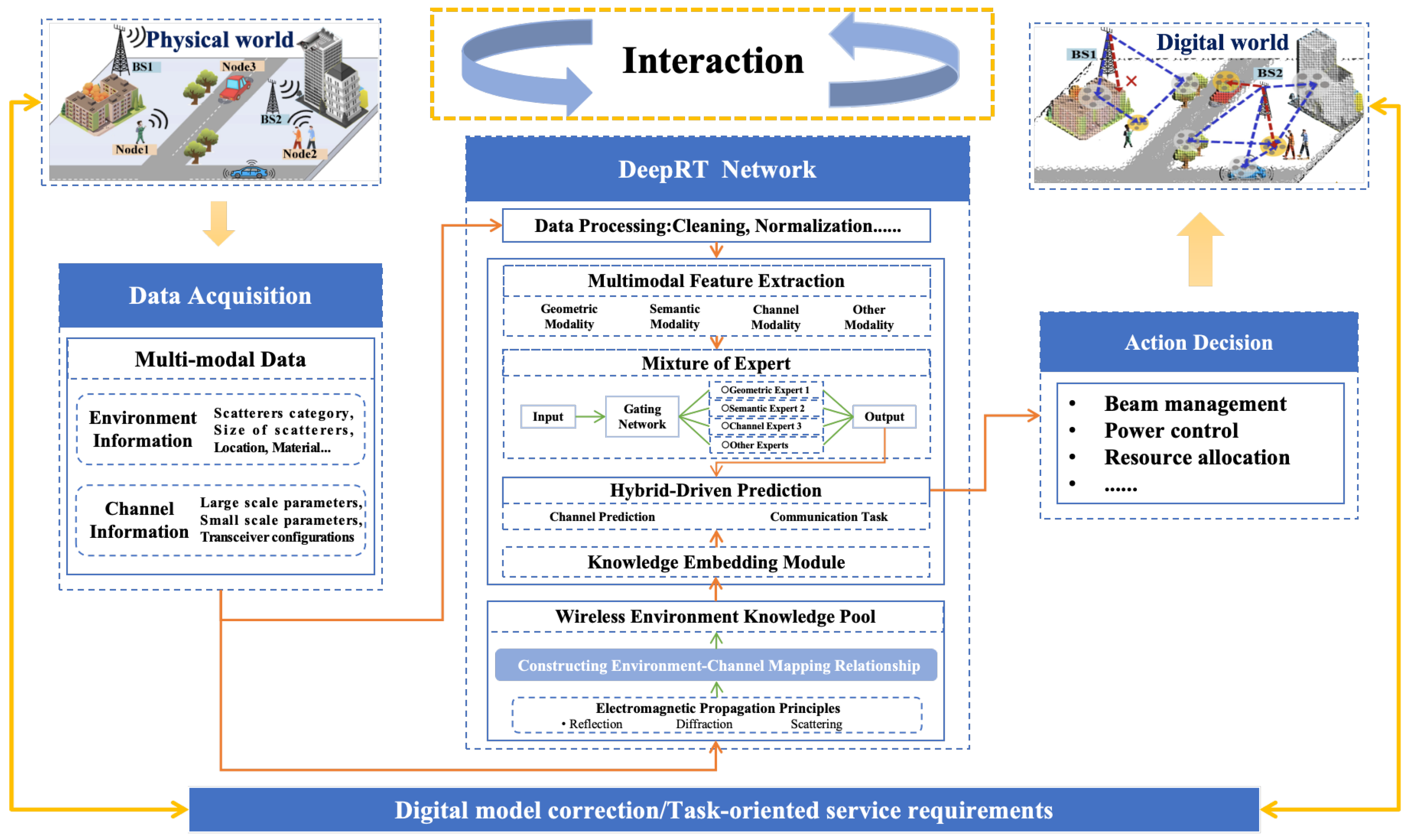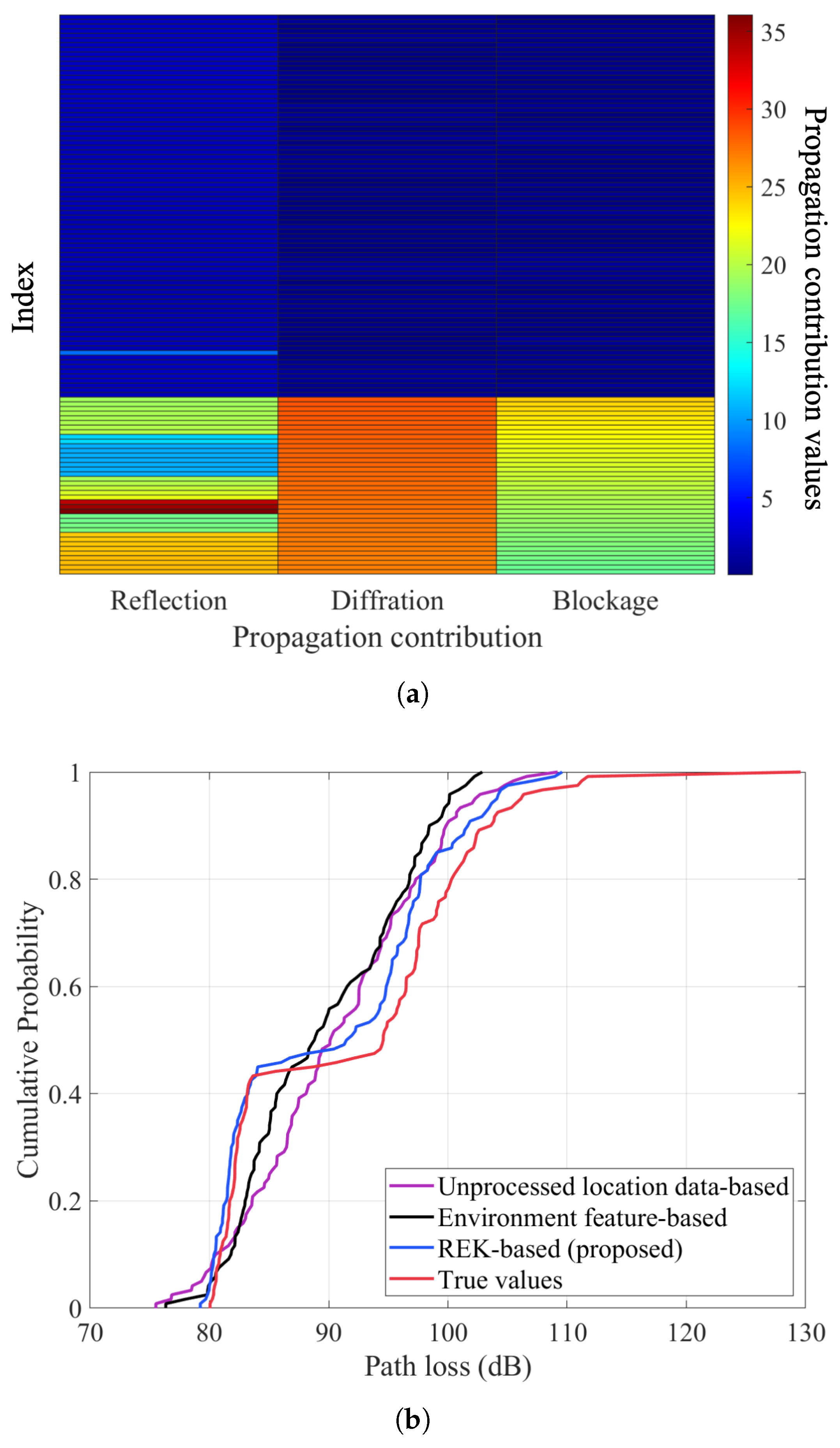DeepRT: A Hybrid Framework Combining Large Model Architectures and Ray Tracing Principles for 6G Digital Twin Channels
Abstract
1. Introduction
2. Framework of DTC
2.1. What Is the DTC?
2.2. Framework
- Sensing: As noted in [3,4], two main types of information are required: environmental information and channel information. In this module, multi-modal data are collected from the physical world using various sensing devices such as cameras, radar, and GPS. These devices capture environmental information, including the location, size, and material of scatterers, as well as environmental maps. At the same time, channel information, another type of critical information for the DTC, is obtained from wireless communication devices. Then, the collected multi-modal and heterogeneous data undergo denoising, feature extraction, and dimensionality reduction, enabling an accurate reconstruction of the physical entities in the digital world. A summary of related work is presented in Table 1.
| Ref. | Source | Method | Ability |
|---|---|---|---|
| [20] | Environment sensing devices | A sensing-enhanced radio environment prediction platform | Swiftly reconstruct the physical environment |
| [21] | Communication signaling with camera image | Multi-user selection and Multi-modal fusion | Increases the accuracy and robustness of environment reconstruction |
| [22] | LiDAR point cloud data | Pre-processing and post-processing techniques | Real-time mapping for digital twin development |
| [23] | Radio frequency data | Deep learning | Paving the way towards lightweight and scalable reconstructions |
| [24] | Channel knowledge map | Combines physical environment maps with deep learning techniques | Constructing detailed spatiotemporal maps of channel characteristics |
- Prediction: The collected multi-modal data are further processed to explore and establish the relationship between environmental information and channel data. AI techniques are employed to enable accurate channel prediction. For example, the wireless environment knowledge pool (WEKP) is proposed to explore the relationship between the channel and the environment, thereby providing prior knowledge for channel prediction [4]. An environment feature-based model is presented for predicting path loss using random forest methods [25]. Similarly, the study in [26] proposes a framework for millimeter-wave communication systems based on environmental semantics, using AI methods to extract semantic information in image form for beam and blockage prediction.
- Decision and interaction: Communication decisions are made in the digital world for the served users based on predicted channel data and then transmitted to the physical world. Subsequently, the DTC engages in continuous interaction with the physical environment via a feedback mechanism, iteratively updating its models and data. This closed-loop process enhances the accuracy of digital–physical mapping and ensures more reliable and adaptive decision-making.
3. DeepRT Enabled DTC
3.1. Traditional RT-Enabled Level-3 Intermediate Twin
3.2. RT and AI Methods Enabled Level-4 Advanced Twin
3.3. DeepRT Enabled Level-5 DTC
3.3.1. Framework
- Data acquisition: Multi-modal data are collected from the physical world, including both environmental information and channel information. These data are sourced from base stations, environmental sensors, and user terminals. For example, 2D cameras capture RGB images, depth cameras provide depth maps, and LiDAR or 3D cameras extract point clouds. Additionally, real-time transceiver configurations (e.g., the location, frequency, bandwidth, and antenna) and multi-dimensional channel feedback (e.g., CIR, angle, delay, and power) are collected to support dynamic prediction and DRT-DTC adaptation. These multi-modal data sources provide a rich and accurate informational foundation for environment reconstruction and subsequent channel prediction. Through a sensor network and edge computing platforms, real-time data streams are transmitted to the DeepRT network for further processing and analysis.
- DeepRT network: The collected multi-modal data are processed and analyzed in this module, and communication decisions are made. The process consists of the following key steps:
- Data processing: Data collected from various sources undergo cleaning, normalization, and temporal processing to ensure quality and consistency. This step is essential to make the data usable for subsequent analysis. Using multi-modal fusion techniques, the processed data are integrated into a unified representation. This ensures that information from different modalities can be effectively handled in the same space.
- Multi-modal feature extraction: Specialized neural networks, such as deep neural networks, convolutional neural networks, or long short-term memory networks, are used to extract features from each data modality. The model automatically learns high-dimensional features from the data, while self-attention mechanisms are applied to dynamically adjust the weights of each modality feature, enhancing the network’s capacity to capture complex relationships across heterogeneous data sources.
- Wireless environment knowledge pool: Inspired by RT methods, wireless environment knowledge (WEK) can be constructed based on fundamental electromagnetic propagation principles to explore the mapping relationship between the environment and the channel. The WEKP represents the integration and extension of the WEK. The architecture of the WEKP is introduced in [4]. Based on physical laws, the WEKP serves as a physical prior and provides expert knowledge to the network.
- Knowledge embedding: The WEKP is designed to serve as a source of structured domain knowledge and physical constraints within the deep learning framework. Rather than treating knowledge as auxiliary features, this conceptual module aims to embed physically meaningful relationships, such as propagation principles and environmental semantics, into the model’s latent space to guide learning in a physics-consistent manner. Potential implementation approaches include relation-aware attention [45,46], symbolic embeddings [47], or multi-level alignment mechanisms [48] that map knowledge representations to the internal layers of the model. By incorporating the WEKP in this manner, the model is better constrained during training, mitigating issues common in purely data-driven approaches, such as limited generalization and poor adaptability in unfamiliar environments.
- Mixture of experts (MoE) network: The processed multi-modal data are fed into the MoE network, which can dynamically select the most appropriate expert network based on the characteristics of the input data. This ensures that the network chooses the optimal processing path for different types of data. By facilitating the division of labor among multiple sub-networks, the MoE network effectively handles heterogeneous data and adapts to varying environmental conditions.
- Hybrid-driven prediction module: This module first performs wireless channel prediction by combining data-driven learning with physics-informed knowledge. The predicted channel characteristics, such as path loss, delay spread, and spatial parameters, serve as inputs for subsequent decision-making tasks, including spectrum allocation, beamforming, and power control. By integrating both data-driven and physical insights, the module provides more accurate and reliable communication decisions.
- Action decision: The generated communication decisions are transmitted to physical devices and interact with the real-world wireless network. Simultaneously, feedback from the physical world is sent back to the DTC system through a feedback mechanism. Based on this, the model performs online learning, enabling self-updating and optimization. This closed-loop learning cycle ensures that the communication system can consistently make optimal decisions under dynamic environmental and network conditions.
3.3.2. Advantages
- Strong modeling capability: The framework builds a data-model dual-driven network by embedding physical knowledge as expert priors. This design enables the model to learn complex features from data while maintaining consistency with real-world electromagnetic behaviors, thereby enhancing both prediction accuracy and physical consistency.
- Multi-modal fusion: By leveraging large models’ capabilities in handling multi-modal data, the framework integrates heterogeneous sources such as base stations, sensors, and user terminals. Through unified representation and self-attention mechanisms, it enables efficient cross-modal collaboration and the fusion of information.
- Multi-scenario adaptability: The MoE network dynamically selects the most appropriate expert model based on input data characteristics. This dynamic selection empowers the system to adapt to various network environments and data types, ensuring accurate communication decisions across diverse scenarios.
- Online self-learning and optimization: Through feedback mechanisms and online learning, the system performs self-optimization using real-world interaction feedback, ensuring that communication decisions remain optimal under dynamic environments and network conditions.
4. Validation
4.1. WEK-Based AI Methods for Channel Prediction
4.2. Large Models to Enable DTC
5. Challenges and Future Opportunities
6. Conclusions
Author Contributions
Funding
Data Availability Statement
Conflicts of Interest
Abbreviations
| 6G | sixth generation |
| DTC | digital twin channel |
| RT | ray tracing |
| MIMO | multiple-input multiple-output |
| RIS | reconfigurable intelligent surface |
| IoE | Internet of Everything |
| CSI | channel state information |
| WEKP | wireless environment knowledge pool |
| WEK | wireless environment knowledge |
| PL | path loss |
| CIR | channel impulse response |
| GO | geometric optics |
| UTD | uniform theory of diffraction |
| SBR | shooting and bouncing rays |
| ISAC | integrated sensing and communication |
| XL-MIMO | extra-large-scale multiple-input multiple-output |
| SA | simulated annealing |
| ML | machine learning |
| NN | neural networks |
| SR | super-resolution |
| MoE | mixture of experts |
| NRMSE | normalized root mean square error |
| RMSE | root mean square error |
| CDF | cumulative distribution function |
| NMSE | normalized mean square error |
References
- ITU. Framework and Overall Objectives of the Future Development of IMT for 2030 and Beyond; International Telecommunication Union: Geneva, Switzerland, 2023; Available online: https://www.itu.int/rec/R-REC-M.2160-0-202311-I/en (accessed on 29 April 2025).
- Molisch, A.F. Wireless Communications; John Wiley & Sons: Hoboken, NJ, USA, 2012; p. 34. [Google Scholar]
- Wang, H.; Zhang, J.; Nie, G.; Yu, L.; Yuan, Z.; Li, T.; Wang, J.; Liu, G. Digital Twin Channel for 6G: Concepts, Architectures and Potential Applications. IEEE Commun. Mag. 2024, 63, 24–30. [Google Scholar] [CrossRef]
- Wang, J.; Zhang, J.; Zhang, Y.; Sun, Y.; Nie, G.; Shi, L.; Zhang, P.; Liu, G. Radio Environment Knowledge Pool for 6G Digital Twin Channel. IEEE Commun. Mag. 2025, 63, 158–164. [Google Scholar] [CrossRef]
- Naruniranat, S.; Huang, Y.; Parsons, D. A Three-Dimensional Image Ray Tracing (3D-IRT) Method for Indoor Wireless Channel Characterisation. In Proceedings of the MTT/ED/AP/LEO Societies Joint Chapter, United Kingdom and Republic of Ireland Section, 1999 High Frequency Postgraduate Student Colloquium (Cat. No. 99TH8409), Leeds, UK, 17 September 1999; pp. 62–67. [Google Scholar] [CrossRef]
- Torres, R.P.; Valle, L.; Domingo, M.; Loredo, S. An Efficient Ray-Tracing Method for Radiopropagation based on the Modified BSP Algorithm. In Proceedings of the Gateway to 21st Century Communications Village, VTC 1999-Fall, IEEE VTS 50th Vehicular Technology Conference (Cat. No. 99CH36324), Amsterdam, The Netherlands, 19–22 September 1999; pp. 1967–1971. [Google Scholar] [CrossRef]
- Chen, Y.; Li, Y.; Han, C.; Yu, Z.; Wang, G. Channel Measurement and Ray-Tracing-Statistical Hybrid Modeling for Low-Terahertz Indoor Communications. IEEE Trans. Wirel. Commun. 2021, 20, 8163–8176. [Google Scholar] [CrossRef]
- Pyhtilae, J.; Kokkoniemi, J.; Sangi, P.; Vaara, N.; Juntti, M. Ray Tracing Based Radio Channel Modelling Applied to RIS. In Proceedings of the WSA & SCC 2023; 26th International ITG Workshop on Smart Antennas and 13th Conference on Systems, Communications, and Coding, Braunschweig, Germany, 27 February 2023; pp. 1–6. [Google Scholar]
- Alkhateeb, A.; Jiang, S.; Charan, G. Real-Time Digital Twins: Vision and Research Directions for 6G and Beyond. IEEE Commun. Mag. 2023, 61, 128–134. [Google Scholar] [CrossRef]
- Jiang, W.; Schotten, H.D. Deep Learning for Fading Channel Prediction. IEEE Open J. Commun. Soc. 2020, 1, 320–332. [Google Scholar] [CrossRef]
- Wu, L.; He, D.; Ai, B.; Wang, J.; Qi, H.; Guan, K.; Zhong, Z. Artificial Neural Network Based Path Loss Prediction for Wireless Communication Network. IEEE Access 2020, 8, 199523–199538. [Google Scholar] [CrossRef]
- Zhou, T.; Zhang, H.; Ai, B.; Xue, C.; Liu, L. Deep-Learning-Based Spatial-Temporal Channel Prediction for Smart High-Speed Railway Communication Networks. IEEE Trans. Wirel. Commun. 2022, 21, 5333–5345. [Google Scholar] [CrossRef]
- Fan, S.; Li, H.; Liang, X.; Liu, Z.; Gu, X.; Zhang, L. E2ENet: An End-to-End Channel Prediction Neural Network Based on Uplink Pilot for FDD Systems. IEEE Wirel. Commun. Lett. 2024, 13, 1285–1289. [Google Scholar] [CrossRef]
- Simmons, N.; Gomes, S.B.F.; Yacoub, M.D.; Simeone, O.; Cotton, S.L.; Simmons, D.E. AI-Based Channel Prediction in D2D Links: An Empirical Validation. IEEE Access 2022, 10, 65459–65472. [Google Scholar] [CrossRef]
- Liu, B.; Liu, X.; Gao, S.; Cheng, X.; Yang, L. LLM4CP: Adapting Large Language Models for Channel Prediction. J. Commun. Inf. Netw. 2024, 9, 113–125. [Google Scholar] [CrossRef]
- Shao, J.; Tong, J.; Wu, Q.; Guo, W.; Li, Z.; Lin, Z.; Zhang, J. WirelessLLM: Empowering Large Language Models towards Wireless Intelligence. J. Commun. Inf. Netw. 2024, 9, 99–112. [Google Scholar] [CrossRef]
- Yang, T.; Zhang, P.; Zheng, M.; Shi, Y.; Jing, L.; Huang, J.; Li, N. WirelessGPT: A Generative Pre-trained Multi-task Learning Framework for Wireless Communication. arXiv 2025, arXiv:2502.06877. [Google Scholar] [CrossRef]
- Qiu, K.; Bakirtzis, S.; Wassell, I.; Song, H.; Zhang, J.; Wang, K. Large Language Model-Based Wireless Network Design. IEEE Wirel. Commun. Lett. 2024, 13, 3340–3344. [Google Scholar] [CrossRef]
- Chen, Z.; Zhang, Z.; Yang, Z. Big AI Models for 6G Wireless Networks: Opportunities, Challenges, and Research Directions. IEEE Wirel. Commun. 2024, 31, 164–172. [Google Scholar] [CrossRef]
- Miao, Y.; Zhang, Y.; Zhang, J.; Sun, Y.; Tian, Y.; Yu, L.; Liu, G. Demo Abstract: Predictive Radio Environment for Digital Twin Communication Platform via Enhanced Sensing. In Proceedings of the IEEE INFOCOM 2023-IEEE Conference on Computer Communications Workshops (INFOCOM WKSHPS), Hoboken, NJ, USA, 20 May 2023; pp. 1–2. [Google Scholar] [CrossRef]
- Lin, B.; Zhao, C.; Gao, F.; Ye Li, G.; Qian, J.; Wang, H. Environment Reconstruction Based on Multi-User Selection and Multi-Modal Fusion in ISAC. IEEE Trans. Wirel. Commun. 2024, 23, 15083–15095. [Google Scholar] [CrossRef]
- Brock, E.; Huang, C.; Wu, D.; Liang, Y. Lidar-Based Real-Time Mapping for Digital Twin Development. In Proceedings of the 2021 IEEE International Conference on Multimedia and Expo (ICME), Shenzhen, China, 5–9 July 2021; pp. 1–6. [Google Scholar] [CrossRef]
- Khachatrian, H.; Mkrtchyan, R.; Raptis, T.P. Outdoor Environment Reconstruction with Deep Learning on Radio Propagation Paths. In Proceedings of the 2024 International Wireless Communications and Mobile Computing (IWCMC), Ayia Napa, Cyprus, 27–31 May 2024; pp. 1498–1503. [Google Scholar] [CrossRef]
- Zeng, Y.; Chen, J.; Xu, J.; Wu, D.; Xu, X.; Jin, S.; Gao, X.; Gesbert, D.; Cui, S.; Zhang, R. A Tutorial on Environment-Aware Communications via Channel Knowledge Map for 6G. IEEE Commun. Surv. Tutor. 2024, 26, 1478–1519. [Google Scholar] [CrossRef]
- Sun, Y.; Zhang, J.; Zhang, Y.; Yu, L.; Yuan, Z.; Liu, G.; Wang, Q. Environment Features-Based Model for Path Loss Prediction. IEEE Wirel. Commun. Lett. 2022, 11, 2010–2014. [Google Scholar] [CrossRef]
- Yang, Y.; Gao, F.; Tao, X.; Liu, G.; Pan, C. Environment Semantics Aided Wireless Communications: A Case Study of mmWave Beam Prediction and Blockage Prediction. IEEE J. Sel. Areas Commun. 2023, 41, 2025–2040. [Google Scholar] [CrossRef]
- Yun, Z.; Iskander, M.F. Ray Tracing for Radio Propagation Modeling: Principles and Applications. IEEE Access 2015, 3, 1089–1100. [Google Scholar] [CrossRef]
- Kouyoumjian, R.G.; Pathak, P.H. A Uniform Geometrical Theory of Diffraction for an Edge in a Perfectly Conducting Surface. Proc. IEEE 1974, 62, 1448–1461. [Google Scholar] [CrossRef]
- Arnold, M.; Bauhofer, M.; Mandelli, S.; Henninger, M.; Schaich, F.; Wild, T.; ten Brink, S. MaxRay: A Raytracing-based Integrated Sensing and Communication Framework. In Proceedings of the 2022 2nd IEEE International Symposium on Joint Communications & Sensing (JC&S), Seefeld, Austria, 9–10 March 2022; pp. 1–7. [Google Scholar] [CrossRef]
- Schüßler, C.; Hoffmann, M.; Bräunig, J.; Ullmann, I.; Ebelt, R.; Vossiek, M. A Realistic Radar Ray Tracing Simulator for Large MIMO-Arrays in Automotive Environments. IEEE J. Micro 2021, 1, 962–974. [Google Scholar] [CrossRef]
- Liu, Y.; Sarris, C.D. Propagation Modeling for RIS-Enabled Channels Based on Ray-Tracing and the Equivalence Principle. In Proceedings of the 2023 IEEE International Symposium on Antennas and Propagation and USNC-URSI Radio Science Meeting (USNC-URSI), Portland, OR, USA, 23–28 July 2023; pp. 19–20. [Google Scholar] [CrossRef]
- Yun, Z.; Iskander, M.F.; Lim, S.Y. The Effect of 3D Building Reconstruction Errors on Propagation Prediction Using Geospatial Data in Cyberspace. In Proceedings of the 2009 IEEE Antennas and Propagation Society International Symposium, North Charleston, SC, USA, 1–5 June 2009; pp. 1–4. [Google Scholar] [CrossRef]
- Tan, J.; Su, Z.; Long, Y. A Full 3-D GPU-Based Beam-Tracing Method for Complex Indoor Environments Propagation Modeling. IEEE Trans. Antennas Propag. 2015, 63, 2705–2718. [Google Scholar] [CrossRef]
- Jemai, J.; Eggers, P.C.; Pedersen, G.F.; Kurner, T. Calibration of a UWB Sub-Band Channel Model Using Simulated Annealing. IEEE Trans. Antennas Propag. 2009, 57, 3439–3443. [Google Scholar] [CrossRef]
- Orekondy, T.; Kumar, P.; Kadambi, S.; Ye, H.; Soriaga, J.; Behboodi, A. WiNeRT: Towards Neural Ray Tracing for Wireless Channel Modelling and Differentiable Simulations. In Proceedings of the Eleventh International Conference on Learning Representations (ICLR 2023), Kigali, Rwanda, 1–5 May 2023. [Google Scholar]
- Hoydis, J.; Aoudia, F.A.; Cammerer, S.; Euchner, F.; Nimier-David, M.; Brink, S.T.; Keller, A. Learning Radio Environments by Differentiable Ray Tracing. IEEE Trans. Mach. Learn. Commun. Netw. 2024, 2, 1527–1539. [Google Scholar] [CrossRef]
- Zhang, F.; Zhou, C.; Brennan, C.; Wang, R.; Li, Y.; Xia, G.; Zhao, Z.; Xiao, Y. A Radio Wave Propagation Modeling Method Based on High-Precision 3-D Mapping in Urban Scenarios. IEEE Trans. Antennas Propag. 2024, 72, 2712–2722. [Google Scholar] [CrossRef]
- He, D.; Guan, K.; Yan, D.; Yi, H.; Zhang, Z.; Wang, X.; Zhong, Z.; Zorba, N. Physics and AI-Based Digital Twin of Multi-Spectrum Propagation Characteristics for Communication and Sensing in 6G and Beyond. IEEE J. Sel. Areas Commun. 2023, 41, 3461–3473. [Google Scholar] [CrossRef]
- Lee, J.H.; Molisch, A.F. A Scalable and Generalizable Pathloss Map Prediction. IEEE Trans. Wirel. Commun. 2024, 23, 17793–17806. [Google Scholar] [CrossRef]
- Hehn, T.M.; Orekondy, T.; Shental, O.; Behboodi, A.; Bucheli, J.; Doshi, A.; Namgoong, J.; Yoo, T.; Sampath, A.; Soriaga, J.B. Transformer-Based Neural Surrogate for Link-Level Path Loss Prediction from Variable-Sized Maps. In Proceedings of the 2023 IEEE Global Communications Conference (GLOBECOM 2023), Kuala Lumpur, Malaysia, 4–8 December 2023; pp. 4804–4809. [Google Scholar] [CrossRef]
- Levie, R.; Yapar, Ç.; Kutyniok, G.; Caire, G. RadioUNet: Fast Radio Map Estimation with Convolutional Neural Networks. IEEE Trans. Wirel. Commun. 2021, 20, 4001–4015. [Google Scholar] [CrossRef]
- Guo, D.; Zhu, Q.; Yang, D.; Xie, Z.; Dong, K.; Zhang, W.; Chen, G.; Bi, X.; Wu, Y.; Li, Y.; et al. DeepSeek-Coder: When the Large Language Model Meets Programming—The Rise of Code Intelligence. arXiv 2024, arXiv:2401.14196. [Google Scholar] [CrossRef]
- Bi, X.; Chen, D.; Chen, G.; Chen, S.; Dai, D.; Deng, C.; Ding, H.; Dong, K.; Du, Q.; Fu, Z.; et al. Deepseek LLM: Scaling Open-Source Language Models with Longtermism. arXiv 2024, arXiv:2401.02954. [Google Scholar] [CrossRef]
- Lu, H.; Liu, W.; Zhang, B.; Wang, B.; Dong, K.; Liu, B.; Sun, J.; Ren, T.; Li, Z.; Yang, H.; et al. Deepseek-VL: Toward Real-World Vision-Language Understanding. arXiv 2024, arXiv:2403.05525. [Google Scholar] [CrossRef]
- Cai, W.; Ma, W.; Zhan, J.; Jiang, Y. Entity Alignment with Reliable Path Reasoning and Relation-Aware Heterogeneous Graph Transformer. arXiv 2022, arXiv:2205.08806. [Google Scholar] [CrossRef]
- Sheikh, N.; Qin, X.; Reinwald, B.; Miksovic, C.; Gschwind, T.; Scotton, P. Knowledge Graph Embedding Using Graph Convolutional Networks with Relation-Aware Attention. arXiv 2021, arXiv:2102.07200. [Google Scholar] [CrossRef]
- Xie, Y.; Xu, Z.; Kankanhalli, M.S.; Meel, K.S.; Soh, H. Embedding Symbolic Knowledge into Deep Networks. In Proceedings of the 33rd International Conference on Neural Information Processing Systems, Red Hook, NY, USA, 8 December 2019; pp. 1–11. [Google Scholar]
- Sun, Z.; Wang, C.; Hu, W.; Chen, M.; Dai, J.; Zhang, W.; Qu, Y. Knowledge Graph Alignment Network with Gated Multi-Hop Neighborhood Aggregation. AAAI Conf. Artif. Intell. 2020, 34, 222–229. [Google Scholar] [CrossRef]
- Wang, J.; Zhang, J.; Sun, Y.; Zhang, Y.; Yu, L.; Zhang, Z. Electromagnetic Wave Property Inspired Radio Environment Knowledge Construction and Artificial Intelligence Based Verification for 6G Digital Twin Channel. Front. Inform. Technol. Electron. Eng. 2025, 26, 260–277. [Google Scholar] [CrossRef]
- Shen, Z.; Yu, L.; Zhang, Y.; Zhang, J.; Zhang, Z.; Hu, X.; Han, S.; Jin, J.; Liu, G. DataAI-6G: A System Parameters Configurable Channel Dataset for AI-6G Research. In Proceedings of the 2023 IEEE Globecom Workshops (GC Wkshps), Kuala Lumpur, Malaysia, 4–8 December 2023; pp. 1910–1915. [Google Scholar] [CrossRef]
- Yu, L.; Shi, L.; Zhang, J.; Wang, J.; Zhang, Z.; Zhang, Y.; Liu, G. ChannelGPT: A Large Model to Generate Digital Twin Channel for 6G Environment Intelligence. arXiv 2024, arXiv:2410.13379. [Google Scholar] [CrossRef]





| Ref. | Method | Application | Efficiency | Limitation | |
|---|---|---|---|---|---|
| RT optimization | [33] | GPU and kD-tree | Path-finding | Acceleration | The bottleneck of the physical model, non-task-oriented, non-real time |
| RT dominance | [35] | Neural rendering | Path-finding | Reducing path-finding time | |
| [36] | Model-based NN | Material calibration | Automatic calibration | ||
| [37] | Semantic segmentation | 3D mapping | High precision | ||
| AI dominance | [38] | SR algorithm | Channel data generation | Generating HR propagation data | Requiring data, weak interpretability, small scale |
| [39] | PMNet | PL prediction | Predicting PL fast and accurately | ||
| [40] | Transformer-based model | PL prediction | Adaptation to various maps | ||
| [25] | Environment feature-based model | PL prediction | Environment information acquisition and accurate prediction | ||
| [41] | UNet | Simulating radio maps | Reducing run time and improving accuracy |
| Methods | NRMSE | RMSE (dB) | Training Time (s) | Testing Time (s) |
|---|---|---|---|---|
| Location data-based | 0.565 | 4.212 | 8.21 | 0.227 |
| Environment feature-based | 0.456 | 3.399 | 7.67 | 0.170 |
| Proposed WEK-based | 0.271 | 2.020 | 4.07 | 0.004 |
| Methods | NMSE (Original Scenario) | NMSE (New Scenario) |
|---|---|---|
| RS-WOWEI | 0.0893 | 0.1030 |
| RS-WWEI | 0.0320 | 0.0414 |
| ChannelGPT | 0.0128 | 0.0129 |
Disclaimer/Publisher’s Note: The statements, opinions and data contained in all publications are solely those of the individual author(s) and contributor(s) and not of MDPI and/or the editor(s). MDPI and/or the editor(s) disclaim responsibility for any injury to people or property resulting from any ideas, methods, instructions or products referred to in the content. |
© 2025 by the authors. Licensee MDPI, Basel, Switzerland. This article is an open access article distributed under the terms and conditions of the Creative Commons Attribution (CC BY) license (https://creativecommons.org/licenses/by/4.0/).
Share and Cite
Li, M.; Wu, T.; Dong, Z.; Liu, X.; Lu, Y.; Zhang, S.; Wu, Z.; Zhang, Y.; Yu, L.; Zhang, J. DeepRT: A Hybrid Framework Combining Large Model Architectures and Ray Tracing Principles for 6G Digital Twin Channels. Electronics 2025, 14, 1849. https://doi.org/10.3390/electronics14091849
Li M, Wu T, Dong Z, Liu X, Lu Y, Zhang S, Wu Z, Zhang Y, Yu L, Zhang J. DeepRT: A Hybrid Framework Combining Large Model Architectures and Ray Tracing Principles for 6G Digital Twin Channels. Electronics. 2025; 14(9):1849. https://doi.org/10.3390/electronics14091849
Chicago/Turabian StyleLi, Mingyue, Tao Wu, Zhirui Dong, Xiao Liu, Yiwen Lu, Shuo Zhang, Zerui Wu, Yuxiang Zhang, Li Yu, and Jianhua Zhang. 2025. "DeepRT: A Hybrid Framework Combining Large Model Architectures and Ray Tracing Principles for 6G Digital Twin Channels" Electronics 14, no. 9: 1849. https://doi.org/10.3390/electronics14091849
APA StyleLi, M., Wu, T., Dong, Z., Liu, X., Lu, Y., Zhang, S., Wu, Z., Zhang, Y., Yu, L., & Zhang, J. (2025). DeepRT: A Hybrid Framework Combining Large Model Architectures and Ray Tracing Principles for 6G Digital Twin Channels. Electronics, 14(9), 1849. https://doi.org/10.3390/electronics14091849








